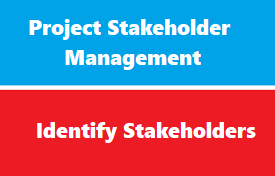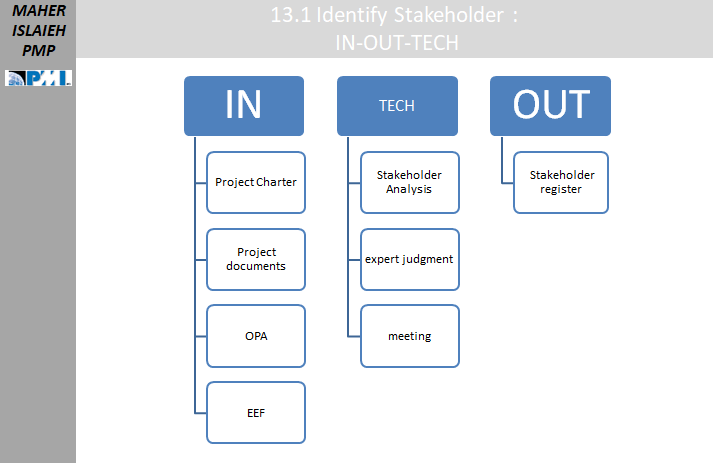introduction
Identify Stakeholders is the process of identifying the people, groups, or organizations that could impact or be impacted by a decision, activity, or outcome of the project, analyzing and documenting relevant information regarding their interests, involvement, interdependencies, influence, and potential impact on project success.
The key benefit of this process is that it allows the project manager to identify the appropriate focus for each stakeholder or group of stakeholders
What is Stakeholder
a stakeholder is a person or group of people who can
- affect
- or be affected by a project.
Stakeholders can be
- individuals working on a project,
- groups of people or organizations,
- or even entity of community
A stakeholder may be:
- actively involved in a project’s work,
- affected by the project’s outcome,
- or in a position to affect the project’s success.
Stakeholders can be
- an internal part of a project’s organization,
or external, such as customers, creditors, unions, or members of a community.
who is stakeholder ?
After we see what is stakeholder >> this will lead us to second level :
who is a stakeholder?
This question is answered during the stakeholder identification process.
Stakeholder identification is the process used to identify all stakeholders for a project.
It is important to understand that not all stakeholders will have the same influence or effect on a project, nor will they be affected in the same manner.
There are many ways to identify stakeholders for a project; however
OK ,,,
Now let us to next question
How to define stakeholder
This may be done by looking at stakeholders organizationally, geographically, or by involvement with various project phases or outcomes.
Another way of determining stakeholders is to identify those who are directly impacted by the project and those who may be indirectly affected.
Identify Stakeholders process
You may notices that stake holder is one of Only two process in initiating phase (beside of develop charter process )
Identifying stakeholders should happen as soon as possible within the initiating process group.
Identifying stakeholders is a process of identifying people, groups, or organizations who could impact or be impacted by the project outcome.
Stakeholders have varied degrees of interest within any project and it is this degree of interest that makes it essential to grade them on their level of importance and potential impact.
Those stakeholders with the greatest levels of impact, during any given segment of the project lifecycle, require more management than say a stakeholder whose impact is not as great.
Through analysis techniques, each stakeholder is evaluated for their level of power and interest and is plotted on a power versus interest matrix.
The use of this matrix will help project management ensure the proper level of engagement is maintained.
The Project Manager Roles during process :
during process The Project Manager have the following Roles:
- Identifies all stakeholders impacted by the project early in the project,
- Analyzes their interest, expectations, importance and influence – critical to project success to do so
- Documents and classifies stakeholder by their interests, attitude, influence, involvement, and impact in the Stakeholder Register.
- Works closely with the Communications Management Plan
process inputs
Identify Stakeholders: Inputs
. Project Charter
- The project charter contains the statement of what the project is about, and gives authorization to the project manager to run the project. Besides these key functions, however, the project charter contains vital information relevant to specific knowledge areas, including stakeholder management. It should contain a list of the key stakeholders, which is the starting point for this process, as well as information about their responsibilities within the organization.
Business Documents
Project managers need to look at the documents created by business analysts, whose outputs are the business documents listed below. These documents may contain key information about stakeholders that will be useful in doing this process.
- Business case–identifies the project objectives and identifies an initial list of stakeholders affected by the project.
- Benefits management plan–benefits management does not have to do with human resources; in the language of PMI, it refers to realizing the benefits claimed in the business case. Stakeholders are identified that will benefit from the delivery of the outcomes of the project.
Project Management Plan
The two components of the overall project management plan that are used in the course of this process are the communications management plan and the procurement management plan. These knowledge areas are linked; as mentioned above, stakeholder management developed as an outgrowth of communications management.
- Communications management plan–contains information about how to communicate with the various types of stakeholders
- Stakeholder engagement plan–identifies management strategies and actions required to effectively engage stakeholders in general
Project Documents
Although project documents are not available for the initial stakeholder identification, they will be useful for stakeholder identification that occurs throughout the project.
- Change log–may be updated to introduce a new stakeholder or change the nature of an existing stakeholder’s relationship to the project (this can happen if the person’s job description within the organization changes)
- Issue log–may be updated if new issues introduce a new stakeholder or change the type of participation of existing stakeholders
- Requirements documentation–may provide information on potential stakeholders that are relevant to specific requirements of the project
Agreements
- The parties to an agreement are project stakeholders, whether the agreements are with sellers who provide procurements or with other organizations who are sharing the project work.
Enterprise Environmental Factors
- Government or industry standards
- Global, regional, or local trends
Organizational Process Assets
- Stakeholder register templates and instructions, and actual stakeholder registers from previous projects
- Lessons learned repository with information about the involvement of stakeholders.
process techniques
Identify Stakeholders: Tools and Techniques
Expert Judgment
expertise should be considered from people who have specialized knowledge in:
- Understanding the politics and power structures in the organization
- Knowledge of the industry or type of project deliverable
- Knowledge of the wider environment and culture including customers
- Knowledge of individual team members contributions and expertise
Data Gathering
Here are the techniques for gathering data that can be used for this process.
- Questionnaires and surveys–these can include one-one-on interviews or focus group sessions
- Brainstorming–this elicits input from groups such as team members of subject matter experts
Data Analysis
how do you analyze gathered data ?
- Stakeholder analysis–stakeholders are listed together with their
- positions in the organization
- relationship to the project (are they on the project, are they affected by the outcome of the project, can they affect the outcome of the project)
- stake in the project (do they have relevant knowledge, resources, ownership or rights to an asset or property, or interest in the project’s outcome)
- Document analysis–the repository of lessons learned from previous projects may contain information that may help identify stakeholders for the current project
Data Representation
Once you’ve analyzed the data in the techniques listed above, how to you represent them in order to prepare the stakeholder register
Meetings
Meetings are used to develop an understanding of significant project stakeholders through brainstorming techniques that gather and analyze data. They can take the form of
- Facilitation workshops
- Small group guided discussions
- Virtual groups (using electronics or social media technologies)
process outputs
Identify Stakeholders: Outputs
Stakeholder Register
This document contains the following information about identified stakeholders:
- Identification information–name, organization position, location and contact details, and role on the project.
- Assessment information–major requirements, expectations, potential for influencing project outcomes, and the phase of the project life cycle where the stakeholder has the most influence or impact.
- Stakeholder classification–Internal/external, impact/influence (or power/interest), upward/downward/outward/sideward influence, or any other classification model chosen by the project manager.
Change Requests
- The initial iteration of identifying stakeholders will not generate change requests. However, as stakeholder identification continues throughout the project, new stakeholders or new information about the stakeholders may result in a change request.
Project Management Plan Updates
the main component that will be updated is
- Stakeholder management plan–agreed-upon communication strategies for identified stakeholders are recorded in the stakeholder engagement plan.
Additional components of the overall project management plan that may be updated may include the following:
- Requirements management plan–newly identified stakeholders can impact how requirement activities will be planned, tracked, and reported.
- Communications management plan–stakeholder communication requirements and agreed-upon communications strategies are recorded in the communications management plan.
- Risk management plan–if stakeholder communication requirements and agreed-upon communications strategies affect the approach to managing risk on the project, this is reflected in the risk management plan.
Project Documents Updates
- Assumption log–much of the information about the relative power, interest, and engagement level of stakeholders is based on assumptions, which are entered into the assumption log. Any constraints associated with interacting with specific stakeholders are entered as well.
- Issue log–new issues raised as a result of identifying stakeholders are recorded in the issue log.
- Risk register–New risks identified during this process of identifying stakeholders are recorded in the risk register and managed during the risk management process.


